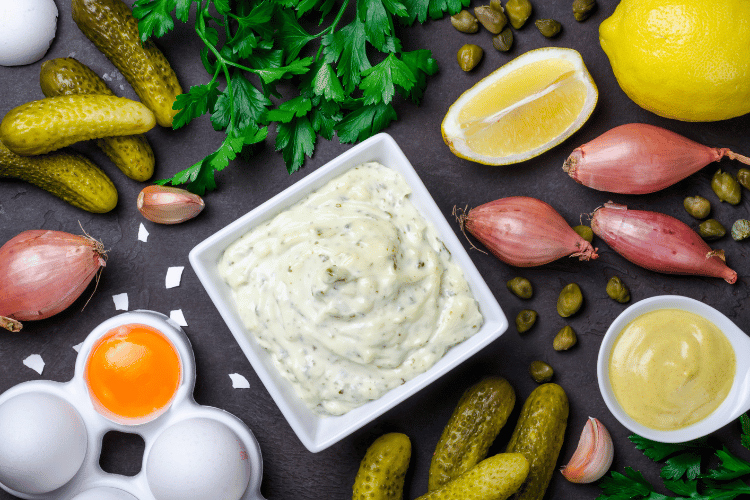Remoulade and aioli are two cold sauces that people refer to interchangeably. Mostly, this is because they both share a mayonnaise base. Yet, traditional aioli doesn’t usually contain mayonnaise!
Cooking purists will tell you that the remoulade and aioli are nothing alike. Remoulade has four varieties, ranging in flavor from earthy to spicy, while aioli is just garlic and oil.

In this article, we’ll compare remoulade vs. aioli as well as help you master the two sauces. Let’s dive in!
What Is Remoulade?
Remoulade is a cold sauce made primarily from eggs. It’s incredibly similar to mayonnaise and can even be described as a zestier version of the popular condiment.
Typically, remoulade uses mayonnaise as a base, adding herbs and seasonings to make a tangy sauce.
There are many varieties of the cold sauce. In France, the mayonnaise-based sauce is made with savory herbs. It’s a popular side dish of fish, hot dogs, and fries.
Danish remoulade is sweet and sour. It combines unique ingredients you wouldn’t expect in one dish, but surprisingly, they work amazingly. This remoulade contains cabbage, cucumber, sugar, and curry!
On the other hand, the United States has its interpretation of remoulade. For starters, remoulade in Creole cuisine is pink, spicy, and contains various vegetables.
In Central Mississippi, the condiment is simple, consisting only of mayonnaise and chili sauce. It’s mainly used for sipping and is called comeback sauce.
What Is Aioli?
Aioli is one of the simplest sauces out there. Its ingredients are in the name!
The cold sauce is an emulsion of oil and garlic. Though, some chefs might experiment by adding extra herbs and seasonings.
Aioli is a Mediterranean condiment. Yet, different countries have their own spin on the sauce.
Some European countries add eggs to further emulsify the sauce. Others might incorporate tomatoes, mustard, lemon juice, or crackers for extra flavoring.
Differences Between Remoulade vs. Aioli
Many people confuse remoulade and aioli. After all, the two sauces are cold, and their variations include mayonnaise, eggs, and garlic. However, the two sauces couldn’t be more different.
Here are the main distinctions between remoulade and aioli:
Origin
It can be easy to determine the origin of the two classic sauces from their names. Remoulade is a French sauce that quickly spread throughout Europe due to its simple ingredients, yet unique taste.
Traditionally, the sauce was the main part of the tangy entree, céleri rémoulade. As its popularity increased, each country had its own spin on it, ending with the spicy Creole remoulade. The latter is even available ready-made!
As for aioli, it’s a Mediterranean sauce. Though, it’s trickier to pinpoint the exact country of origin. The ancient recipe has a history in the cuisine of the Spanish coast, Italy, and Malta.
Ingredients
The major difference between traditional remoulade and aioli has to be the ingredients. Both sauces include simple ingredients that you already have in your pantry. However, the base of the remoulade is mayonnaise, while aioli is an oil emulsion.
To explain, remoulade is always made with mayonnaise. You can combine this ingredient with whole grain or Creole mustard, dill pickles, radish, parsley, curry, or hot cayenne peppers.
Aioli is essentially just olive and garlic. When the two ingredients are blended well, the resulting sauce is white and creamy aioli. Some versions of the sauce include lemon juice, vinegar, egg yolk, or mustard.
Each remoulade ingredient variation results in a completely distinct taste. In contrast, the various supplies you might use to make aioli only serve to stabilize the emulsion instead of altering the taste.
Taste
Though both remoulade and aioli are cold sauces, their flavors are entirely different. To start, remoulade is a sharp-flavored condiment.

Its base flavor is zesty because of the mayonnaise and pickles. Yet, it can be spicy, earthy, or peppery depending on the seasonings.
While there are four basic types of remoulade sauce, the possibilities are endless when it comes to its flavor profile. You can add any vegetables or herbs you want, as long as you have the correct base.
Aioli is a garlic sauce, first and foremost. You can add lemon zest, as in toum, sesame paste as in tahini, or an egg yolk to help emulsify the condiment. However, the garlic flavor will persist.
Uses
Remoulade and aioli taste nothing alike. However, both are perfect dipping sauces. If you want to add more vegetables to your diet, simply use these two sauces as a dip!
That said, the taste profile of the cold sauces makes them more compatible with some dishes than others.
Remoulade is the jack-of-all-sauces. You can use it as a side to finger foods, a salad dressing, or a spread! Here are the best dishes that include remoulade:
- Potato salad
- Hamburgers
- BLT sandwiches
- Crab cakes
- French fries
Aioli is an incredibly versatile sauce. It’s stable on many European menus. You might find it served as a dipping sauce or as a side to seafood.
Here are some other uses for aioli:
- Wraps and Panini
- Lamb and rabbit
- Grilled snails
- Boiled cod
Substitutes
If you’re still unsure what remoulade or aioli tastes like or how you can use them in different dishes, you might find it helpful to know their substitutes.
To start, remoulade is mayonnaise mixed with different herbs and seasonings. It’s usually tangy. So, here are similar, zesty condiments:
- Mayonnaise
- Tartar sauce
- Thousand island sauce
As for aioli, you can just use plain garlic as a substitute! Still, if you’re looking for a twist on the traditional aioli recipe, here are some other sauces you should try out:
- Toum
- Tzatziki sauce
- Taleya
- Sweet chili garlic sauce
How to Make Remoulade Sauce
Remoulade sauce is one of the easiest sauces you can make. Yet, the flavor profile will convince your dinner guests that you spent hours making it.
As you probably know by now, remoulade can be anything you want. Though, in this recipe, we’ve opted for Louisiana-style Creole remoulade. It’s spicy, zesty, and creamy.
Ingredients
- 1 cup mayonnaise
- ¼ cup mustard
- 1 teaspoon creole seasoning
- 2 teaspoons paprika
- 1 teaspoon pickle juice, or diced pickled for an extra crunch
- 1 teaspoon hot sauce of choice
- Finely chopped green onions to taste
Directions
- In a large mixing bowl, combine all the ingredients together.
- Then, add more creole seasoning, hot sauce, or pickle juice to taste.
- Chill the mixture for at least an hour so the flavors meld together.
- Store in the fridge for up to three days.
How to Make Aioli Sauce
Many amateur chefs find making this popular condiment intimidating. After all, how can you achieve the creamy texture of aioli using only olive oil and garlic?
Unlike remoulade, this garlicky sauce combines basic ingredients. In contrast, while you can throw all the remoulade ingredients together, aioli’s mixing method is where all the magic happens.
You can easily make the emulsion using mayonnaise or egg yolk as a base. That said, if you want to master traditional aioli, follow this simple recipe!
Ingredients
- 4 large garlic cloves, peeled
- ½ cup olive oil
- Salt and black pepper to taste (optional)
- Lemon juice (optional)
Directions

- Add the garlic into a mortar, then mash with a pestle into a paste.
- Slowly mix the olive oil into the paste, one tablespoon at a time.
- Thoroughly stir and mash the mixture until the texture is white and creamy.
- The aioli should thicken in minutes. If it gets too thick, you can add water to get the desired consistency.
- Finally, mix in the lemon juice, salt, and pepper.
- If you don’t own a pestle, you can also use a blender, blending in short pulses.
- Serve the aioli while fresh, or store it in the fridge for no more than 24 hours.
Frequently Asked Questions
Can you substitute remoulade for aioli?
Remoulade and aioli pair greatly with almost all dishes. However, if you’re looking for a distinct taste of one of the cold sauces, you can’t replace it with the other.
That’s because remoulade is usually spicy or tangy. Additionally, most remoulade recipes don’t call for garlic. On the other hand, aioli is a pretty garlicky sauce.
Can you make aioli without olive oil?
Aioli contains two ingredients, olive oil, and garlic. Luckily, if you’re out of olive oil or just can’t get the ingredients to emulsify properly, you can use any of the following:
- Egg yolk
- Mustard
- Mayonnaise
- Vegetable oil
- Water and starch
To Conclude
Comparing remoulade vs. aioli is easy. Remoulade is a mayonnaise-based sauce with various herbs and seasonings, and aioli is an emulsion of oil and garlic. Accordingly, it’s easy to understand how each sauce has a distinct flavor profile and uses.
Still, both remoulade and aioli are great as dipping sauces. They also pair perfectly with seafood and as spreads for paninis and wraps.
As for making the sauces, you might find remoulade ingredients harder to come by. In contrast, aioli only requires olive oil and garlic. Though, correctly emulsifying the sauce needs practice.
- How To Fill a King Cake With Bavarian Cream - April 15, 2024
- Dealing With Mold on Oyster Mushrooms - April 9, 2024
- What Meat Goes With Pumpkin Ravioli? (Ravishing Ravioli Combos) - March 15, 2024
